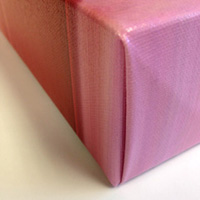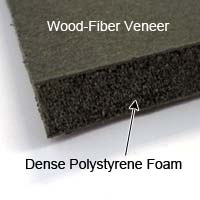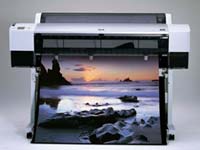| Glossary Of Photography Terms
[16] |
G
Gallery wrap Gallery wrapping is the method of stretching an artist's canvas so that the canvas wraps around the sides of a wooden frame (called stretcher bars or strainer bars), and securing it to the back.The result is that the hardware (staples or tacks) used for securing the canvas is not visible from the front or sides.
The sides of the canvas are prepared and primed in the same manner as the face. They may be painted a solid color, or painted to continue the image appearing on the face. This method of stretching and preparing a canvas allows for a frameless presentation of the finished painting.
In canvas printing, the term “gallery wrap” refers to an image that appears on the sides of the frame as well as the front. The image on the sides is either a continuation or a reflection of the main image.
Order your gallery wrapped canvas print online today! |
 |
Gatorboard A panel composed of a thin sheet of dense foam sandwiched between several layers of thick paper. The result is an extremely rigid and durable base for dry mounting fine art prints and photographs, and lamination.
Order online:
3/16 inch Gatorboard
1/2 inch Gatorboard |
 |
Gelatin A collagen-based substance made from animal by-products. It is best known in its gelatinous form, but actually beings as a brittle, translucent sheet or flakes.
In photography, gelatin can be used in the gelatin silver process. This process involves silver particles mixed with gelatin, which then coat a surface such as glass or paper, used to record the image. The photographic material will be stable for many years with this coating, and the images can be developed after long periods of time. |
Giclée (gee-clay) A digital fine art print made with an inkjet printer. The term is derived from the French gicler (to spray), and refers to the spraying of ink from an inkjet printer onto the printed surface. The earliest giclées were made using Iris printers, which sprayed microscopic drops of color onto a fine art paper or canvas. Capable of displaying the full color spectrum, these artworks have vibrant, brilliant colors, and a velvety texture. This gives the finished product the look and texture of an original painting.
Browse our selection of Giclée canvas prints, and order yours today. |
 |
| GIF GIF, which stands for Graphics Interchange Format, is a popular image file format commonly used for animated images and simple graphics on the web. GIFs support animation and allow multiple frames to be stored within a single file. Each frame can have its own timing, creating the illusion of movement or animation when the frames are displayed sequentially. GIFs are widely used for creating short animations, memes, and looping videos due to their relatively small file size and compatibility with most web browsers and social media platforms. |
| Gigapixel Gigapixel refers to an image containing billions of pixels, typically created by stitching together numerous high-resolution photographs or by using specialized equipment capable of capturing extreme levels of detail. Gigapixel images are characterized by their immense size and level of detail, allowing viewers to zoom in and explore the image at various levels of magnification without losing clarity or sharpness. Gigapixel photography is often used in panoramic landscapes, architectural photography, scientific imaging, and cultural heritage preservation to capture intricate details and provide immersive viewing experiences. |
Gimbal A gimbal is a mechanical device used to stabilize and support cameras, smartphones, or other imaging devices, allowing them to remain steady and level while capturing photos or videos. Gimbals consist of three pivoted rings mounted perpendicular to each other, allowing the camera to rotate smoothly along three axes: pitch, yaw, and roll.
This enables the camera to maintain a stable orientation and counteract unwanted movements such as shaking or vibration, resulting in smoother and more professional-looking footage. Gimbals are widely used in filmmaking, videography, and photography to achieve steady shots, smooth camera movements, and dynamic angles, especially in situations where handheld shooting or movement is required. |
| GIMP GIMP, which stands for GNU Image Manipulation Program, is a free and open-source raster graphics editor widely used for image editing, retouching, and graphic design tasks. GIMP offers a comprehensive set of tools and features for editing digital images, including layer-based editing, color correction, selection tools, painting tools, and support for various file formats. It also supports a wide range of plugins and extensions, allowing users to customize and extend its functionality according to their specific needs. GIMP is available for multiple operating systems, including Windows, macOS, and Linux, making it a popular alternative to commercial image editing software such as Adobe Photoshop. |
GIMP (GNU Image Manipulation Program) GIMP, which stands for GNU Image Manipulation Program, is a free and open-source raster graphics editor widely used for image editing, retouching, and graphic design tasks. GIMP offers a comprehensive set of tools and features for editing digital images, including layer-based editing, color correction, selection tools, painting tools, and support for various file formats.
It also supports a wide range of plugins and extensions, allowing users to customize and extend its functionality according to their specific needs. GIMP is available for multiple operating systems, including Windows, macOS, and Linux, making it a popular alternative to commercial image editing software such as Adobe Photoshop. |
Glazing (1) A technique of applying oil or acrylic color in thin, transparent layers so that the color beneath shows through, modifying the color of the glaze.
(2) The clear cover placed over an artwork within a frame; this may be plastic, plexiglass or real glass. |
| Glossy Finish A high shine finish like that found on traditional photographic prints and resin-coated surfaces. The high degree of reflect creates very vibrant colors, but can obscure the image in certain lighting. |
Golden Hour The golden hour, also known as magic hour, refers to the period shortly after sunrise or before sunset when the sunlight has a warm, soft, and golden quality due to its low angle relative to the horizon. During the golden hour, the sun's rays pass through a thicker layer of the Earth's atmosphere, scattering shorter blue wavelengths and allowing longer red and orange wavelengths to dominate the light spectrum.
This results in soft, diffused light with warm tones that enhances the colors, textures, and contrast in landscapes, portraits, and other photographic subjects. The golden hour is highly prized by photographers for its flattering lighting conditions, long shadows, and dramatic atmospheric effects, making it an ideal time to capture stunning outdoor photographs with rich visual appeal. |
GPS Tagging GPS tagging, also known as geotagging, is the process of adding geographical location information, such as latitude and longitude coordinates, to digital photos or videos captured with a GPS-enabled device. GPS tagging allows photographers to record the precise location where each image was taken, providing valuable metadata that can be used for organizing, categorizing, and searching photos based on location.
GPS tagging is commonly used in travel photography, outdoor photography, and photojournalism to document and share the exact places and landmarks visited during photo shoots. It also enables photographers to create maps, albums, and photo journals that showcase their adventures and experiences in different parts of the world. |
Graduated Filter A graduated filter is a photographic filter that features a gradual transition from one density or color to another across the surface of the filter. Graduated filters are commonly used in landscape photography to balance the exposure between the sky and the foreground in high-contrast scenes, such as sunrises, sunsets, or landscapes with bright skies and darker foregrounds.
The graduated filter is positioned in front of the camera lens with the denser portion covering the brighter area of the scene, gradually transitioning to a clear or less dense portion that covers the darker area. This helps reduce the overall dynamic range of the scene, preventing overexposure in the sky while maintaining detail and clarity in the foreground. Graduated filters come in various types, including neutral density (ND), color, and graduated ND filters, each offering different effects and degrees of light attenuation. |
Graduated ND Filter A graduated ND (Neutral Density) filter is a type of photographic filter that is clear on one side and gradually darkens towards the other side, creating a smooth transition between the two. These filters are primarily used in landscape photography to balance the exposure between the bright sky and the darker foreground.
By positioning the dark portion of the filter over the brighter area (usually the sky) and the clear portion over the darker area (such as the landscape), photographers can reduce the overall contrast in the scene, preventing overexposure in the sky while properly exposing the foreground. Graduated ND filters come in various strengths and sizes to accommodate different lighting conditions and lenses. |
| Grain In photography, grain refers to the visible texture or granularity present in an image, particularly in film photography or in digital images captured using high ISO settings. Grain is caused by the clumping of silver halide crystals in film emulsions or the digital noise generated by electronic sensors in digital cameras when shooting at high ISO sensitivities. While excessive grain can degrade image quality and reduce sharpness, it can also contribute to a certain aesthetic quality, especially in black and white photography or in images where a gritty or vintage look is desired. Grain can be managed and reduced through careful exposure settings, lower ISO values, and noise reduction techniques during post-processing. |
|
© 2002-2024 - KeenART Media Ltd.
|
|
| |
|

